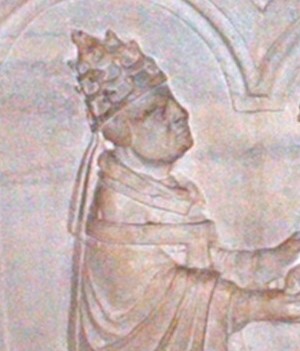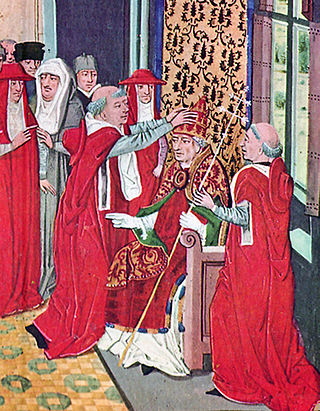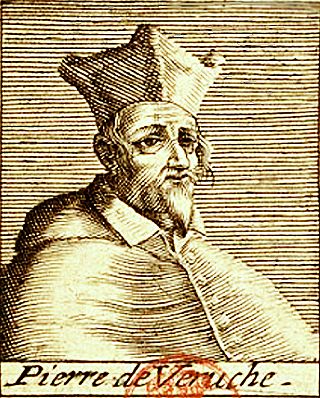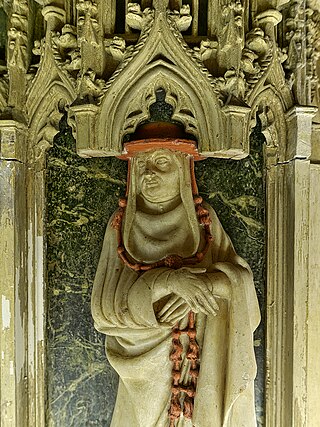
Pope Gregory XI was head of the Catholic Church from 30 December 1370 to his death, in March 1378. He was the seventh and last Avignon pope and the most recent French pope recognized by the modern Catholic Church. In 1377, Gregory XI returned the Papal court to Rome, ending nearly 70 years of papal residency in Avignon, France. His death was swiftly followed by the Western Schism involving two Avignon-based antipopes.

Pope Urban VI, born Bartolomeo Prignano, was head of the Catholic Church from 8 April 1378 to his death, in October 1389. He was the most recent pope to be elected from outside the College of Cardinals. His pontificate began shortly after the end of the Avignon Papacy. It was marked by immense conflict between rival factions as apart of the Western Schism, with much of Europe, such as France, the Iberian Kingdoms of Castile and Aragon, and Scotland recognizing Clement VII, based in Avignon, as the true pope.

The Avignon Papacy was the period from 1309 to 1376 during which seven successive popes resided in Avignon rather than in Rome. The situation arose from the conflict between the papacy and the French crown, culminating in the death of Pope Boniface VIII after his arrest and maltreatment by Philip IV of France. Following the subsequent death of Pope Benedict XI, Philip forced a deadlocked conclave to elect the French Clement V as pope in 1305. Clement refused to move to Rome, and in 1309 he moved his court to the papal enclave at Avignon, where it remained for the next 67 years. This absence from Rome is sometimes referred to as the "Babylonian captivity” of the Papacy.

The Camerlengo of the Holy Roman Church is an office of the papal household that administers the property and revenues of the Holy See. Formerly, his responsibilities included the fiscal administration of the Patrimony of Saint Peter. As regulated in the apostolic constitution Pastor bonus of 1988, the Camerlengo is always a cardinal, though this was not the case prior to the 15th century. His heraldic arms are ornamented with two keys – one gold, one silver – in saltire, surmounted by an ombrellino, a canopy or umbrella of alternating red and yellow stripes. These also form part of the coat of arms of the Holy See during a papal interregnum. The Camerlengo has been Kevin Farrell since his appointment by Pope Francis on 14 February 2019. The Vice Camerlengo has been Archbishop Ilson de Jesus Montanari since 1 May 2020.

The Western Schism, also known as the Papal Schism, the Great Occidental Schism, the Schism of 1378, or the Great Schism, was a split within the Roman Catholic Church lasting from 20 September 1378 to 11 November 1417 in which bishops residing in Rome and Avignon simultaneously claimed to be the true pope, and were eventually joined by a third line of Pisan claimants in 1409. The event was driven by international rivalries, personalities and political allegiances, with the Avignon Papacy in particular being closely tied to the French monarchy.

Pedro Martínez de Luna y Pérez de Gotor, known as el Papa Luna(lit. 'the Moon Pope') or Pope Luna, was an Aragonese nobleman who was christened antipope Benedict XIII during the Western Schism.

Guy de Malsec was a French bishop and cardinal. He was born at the family's fief at Malsec (Maillesec), in the diocese of Tulle. He had two sisters, Berauda and Agnes, who both became nuns at the Monastery of Pruliano (Pruilly) in the diocese of Carcassonne, and two nieces Heliota and Florence, who became nuns at the Monastery of S. Prassede in Avignon. He was a nephew of Pope Gregory XI, or perhaps a more distant relative. He was also a nephew of Pope Innocent VI. Guy was baptized in the church of S. Privatus, some 30 km southeast of Tulle. He played a part in the election of Benedict XIII of the Avignon Obedience in 1394, in his status as second most senior cardinal. He played an even more prominent role in Benedict's repudiation and deposition. Guy de Malsec was sometimes referred to as the 'Cardinal of Poitiers' (Pictavensis) or the 'Cardinal of Palestrina' (Penestrinus).

Jean de Murat du Cros was a French cardinal of the Catholic Church. He became the Bishop of Limoges (1347–1371). He was a leader in what became the Great Schism within Western Christianity.
The Apostolic Chancery was a dicastery of the Roman Curia at the service of the pope. The principal and presiding official was the Grand Chancellor of the Holy Roman Church who was always the cardinal-priest of the Basilica di San Lorenzo in Damaso. The principal function of the office was to collect money to maintain the Papal army and to produce documents and correspondence for the pope. Pope Pius VII reformed the office when Emperor Napoleon I of France obviated the need for Papal armies. In the early 20th century the office collected money for missionary work. Pope Paul VI abolished the Apostolic Chancellary on 27 February 1973, transferring its functions to the Secretariat of State.
Gérard du Puy was a French cardinal of the Roman Catholic Church and cardinal-nephew of Pope Gregory XI.

In the papal conclave held on 29 and 30 December 1370, after the death of Pope Urban V, Cardinal Pierre Roger de Beaufort was elected pope under the name Gregory XI. He thus became seventh and the last pope of the period of Avignon Papacy.

Angel de Grimoard, also recorded as Angelic or Anglic, was a French canon regular and a Cardinal. He was the younger brother of Pope Urban V.

The papal conclave held from 1 May 1314 to 7 August 1316 in the apostolic palace of Carpentras and then the Dominican house in Lyon was one of the longest conclaves in the history of the Roman Catholic Church and the first conclave of the Avignon Papacy. The length of the conclave was due to the division of the cardinals into three factions: Italian, Gascon, and French/Provençal.

The 1378 papal conclave which was held from April 7 to 9, 1378, was the papal conclave which was the immediate cause of the Western Schism in the Catholic Church. The conclave was one of the shortest in the history of the Catholic Church. The conclave was also the first since 1159 held in the Vatican and in Old St. Peter's Basilica.

The Council of Pisa was a controversial council held in 1409. It attempted to end the Western Schism by deposing both Benedict XIII (Avignon) and Gregory XII (Rome) for schism and manifest heresy. The College of Cardinals, composed of members from both the Avignon Obedience and the Roman Obedience, who were recognized by each other and by the Council, then elected a third papal claimant, Alexander V, who lived only a few months. He was succeeded by John XXIII.

Pierre de la Vergne, aka Pierre de Veruche, Pierre Verneyo, Pierre Veruco, Pierre Verrujo or Pierre Veroche, Latin Petrus de Vernio (died 6 October 1403 in Avignon was a French cardinal.

Pierre de Thury was a French bishop and cardinal of the Avignon Obedience, who served as a royal secretary and Master of Requests, and then as papal Nuncio and Apostolic Legate on several occasions. He participated in two papal elections, those of 1394 and 1409, and was a prominent member of the Council of Pisa in 1409.

Niccolò Brancaccio was born in the Kingdom of Naples, perhaps in Naples itself. He was Archbishop of Bari and then Archbishop of Cosenza, while serving in the Roman Curia in Avignon. He became a cardinal of the Avignon Obedience in 1378, and was Cardinal Priest of Santa Maria in Trastevere and then Cardinal Bishop of Albano. He participated in the Council of Pisa in 1409, and was one of the electors of Pope Alexander V and of Pope John XXIII.

Pierre Girard was born in the commune of Saint-Symphorien-sur-Coise, in the Department of Rhone, once in the ancient County of Forez. He died in Avignon on 9 November 1415. He was Bishop of Lodeve and then Bishop of Le Puy. He was a cardinal of the Avignon Obedience during the Great Western Schism, and was promoted to the Bishopric of Tusculum (Frascati). His principal work, however, was as a courtier and administrator at Avignon, and as a papal diplomat.

Martín de Zalba was a Navarrese cleric and statesman who served as the chancellor of the kingdom from 1376 until 1396 and as the bishop of Pamplona from 1377 until his death. From 1390, he was also a cardinal of the Avignon obedience.

















